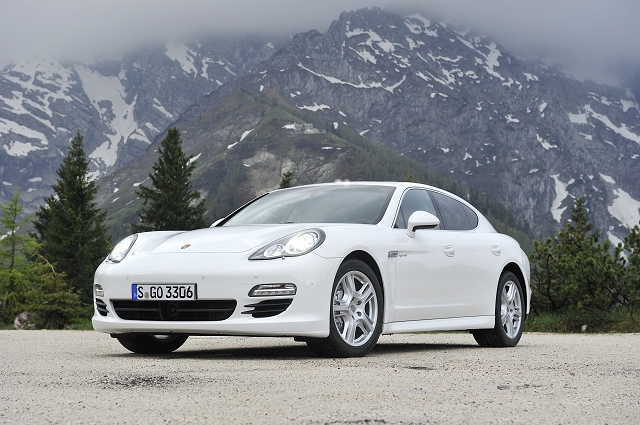Porsche adds a battery and electric motor to a supercharged V6 engine in the Panamera to create the company's most economical car yet with an official combined economy figure or 41.5mpg and CO2 emissions of 159g/km. That's until August, when the Panamera will be offered as a diesel, with a combined economy figure of 44.8mpg.
In the metal 3/5
Although the Porsche Panamera is never a car you're going to fall in love with on the looks front, we've a growing admiration for its lines. The rear remains its most awkward angle, as Porsche perseveres with retaining the 911 styling cues, resulting in a backside heavy hump-backed look. Still, you don't have to look at it when you're driving it, though it certainly attracts attention on the road.
Inside, there's a great driving position, decent space in the rear and fine build quality and materials. Only the slightly clunky operation and increasingly old-school graphics of the satnav let the side down a bit. The most important interior change here though is the addition of the E-Power button, which allows the Panamera to be driven on electricity alone.
Driving it 4/5
The mating of a full parallel hybrid system with the 3.0-litre supercharged V6 petrol engine makes for a completely new Panamera driving experience. Not least as it's possible to drive off in the Panamera S Hybrid using electricity alone. It'll run on battery power for a decent distance too (Porsche claiming about two kilometres in perfect conditions) at speeds of up to 85km/h. It's silent in this mode, and when the 3.0-litre V6 does cut in it does so very smoothly. Indeed, it's not the hybrid system's ability to drive on electricity alone - or 'sail' at motorway speeds using just battery power - that impresses most; it's the near seamless way by in which it juggles between the two motors and eight gears.
While Porsche-like performance remains intact - the S Hybrid reaching 100km/h in six seconds on the way to a 270km/h maximum - there's real pleasure to be had from trying to maximise the Hybrid's efficiency on the road. Drive it conventionally and it's quick, though economy suffers and the supercharged V6 isn't the most soulful sounding powerplant in the line-up. Our chief criticism is with the brakes though. Typically a strong point on Porsches, the regenerative effect gives a leaden pedal that never delivers a consistent level of braking performance - making driving in traffic a sometimes jerky and always frustrating affair.
What you get for your money 3/5
Panameras come very comprehensively specified as standard so you could drive away in a completely standard Panamera S Hybrid. You won't though: it's likely that you'll spend at least 10 per cent on top of the list price on some options. You get bragging rights that your Panamera S Hybrid is the cleanest Porsche around included though, as its 159g/km CO2 emissions betters those of a 2.0-litre petrol Ford Mondeo.
Worth Noting
To achieve that headline CO2 figure and get anywhere near the claimed consumption you'll not only have to drive like a saint, but you'll need to specify low rolling resistance tyres. If you 'forget' to then the Panamera S Hybrid's CO2 emissions rise to 167g/km and the combined consumption rises to 7.1 litres/100km. Still impressive for such a high performance sports saloon, though.
Summary
You'll drive it differently and enjoy the electricity alone silent running, but the S Hybrid's interest lies in countries where buyers can't get their heads around the idea of diesel cars. That limits its appeal in the UK, with the forthcoming diesel Panamera bettering its economy and getting close on CO2 - all for a good bit less money. As a technical demonstration of where Porsche is on hybrids though it's a very impressive car.






















































